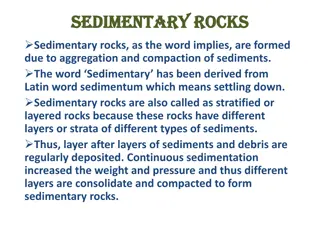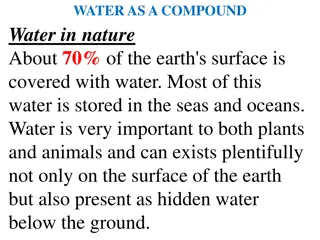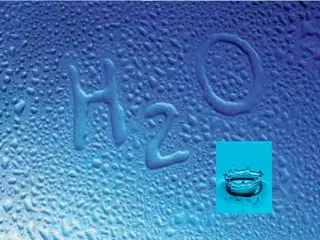Understanding the Water Bearing and Yielding Properties of Rocks
This informative content delves into the significance of porosity and permeability in rock formations, detailing primary and secondary porosity types, factors influencing porosity, and the concept of Darcy's Law governing groundwater flow. It emphasizes the relationship between effective porosity, rock texture, and mineral deposition on porosity levels, highlighting how different rock types influence water-bearing properties. Additionally, it explains the crucial role of permeability in groundwater transmission through rocks of varying porosity levels.
Download Presentation

Please find below an Image/Link to download the presentation.
The content on the website is provided AS IS for your information and personal use only. It may not be sold, licensed, or shared on other websites without obtaining consent from the author. Download presentation by click this link. If you encounter any issues during the download, it is possible that the publisher has removed the file from their server.
E N D
Presentation Transcript
WATER WATER- - BEARING AND WATER BEARING AND WATER YIELDING PROPERTIES OF ROCKS YIELDING PROPERTIES OF ROCKS
INTRODUCTION POROSITY : It is defined as the ratio of the volume of voids in a rock mass to the total volume of the rock which is expressed in percentage Effective porosity : the amount of interconnected space available for flow of water is called effective porosity. Primary porosity : PRIMARY Porosity occurs as intergranular spaces in sedimentary rocks.it depends upon the size shape and the arrangement of sediments . The degree of the compaction and cementation of sediments are also the factors influencing porosity . In volcanic igneous rocks primary porosity is due to the vesicular structure. Secondary porosity : secondary porosity occurs in rocks mainly in the form of 1. joints 2.faults 3. shear zones 4. irregular cracks 5. solution openings in limestones 6.opening of minor importance produced by the work of plants and animals and mechanical erosion.
Factors influencing porosity 1. porosity decreases with depth because density of rocks increase with the increase of depth. 2. In unconsolidated sediments the porosity is more when compared with consolidated rocks. Porosity also depends upon the rock texture A] well sorted sedimentary deposits have high porosity. B]Unsorted sedimentary deposits have low porosity. C] if the mineral matter is deposited in the intergranular space of the sediments their porosity decreases. D] In carbonate rocks thee porosity is developed by solution action. Porosity increases with the increase of grain size. Sediments of the same shape exhibit low porosity when compared with the sediments of different shapes.
Rocks which do not have any porosity cant yield any ground water. Permeability : it is the ability of the rock to transmit water through it. A permeable rock always have high porosity but a highly porous rocks may not have permeable. Ex : clay has high porosity but low permeability. Sand has porosity less than clay but it is highly permeable than clay . Permeability depends on the following factors : A] size of open spaces : larger open spaces allow free flow of water. As the space becomes smaller the permeability decreases. B] inter connection between open spaces C] sorting of grains : well sorted sediments have a higher permeability than unsorted sediments. D] Flow rate :the flow of ground water through a porous medium is very slow.
DARCYS LAW : The movement of ground water depends upon the prevailing effects of gravity ,velocity and pressure of water. Darcy s law may be defined as the flow of water through a porous medium proportional to a factor known as hydraulic gradient or hydraulic conductivity [or] coefficient permeability [k] which is characteristic of porous medium and cross sectional area of an aquifer that is transmitting the water this is expressed as Q= KIA. K= coefficient of permeability Q= volume of water through a medium flowing per unit time through a cross sectional area A under a hydraulic gradient I
Coefficient of permeability : From the above relationship it is clear that the volume of water flow depends upon the factor K . This k is defined as the coefficient of permeability. Transmissibility : literally means permeability . The coefficient of transmissibility [T] is defined as the ratio of flow of water through a vertical strip of the aquifer of unit width and depth under a unit hydraulic gradient . The relation between K and T as follows T=Kd , d= thickness of aquifer, K=coefficient of permeability it is expressed in m2\ day SPECIFIC YIELD : Porosity is a measure of the water bearing capacity of the formation . The volume of the water that can be drained by gravity is called the special yield . It is denoted by Sy
Sy = volume of water pumped out ______________________________ *100 total volume of the material drained Sy = porosity specific retension. SPECIFIC RETENSION : the volume of water retained by molecular and surface tension forces against the forces of gravity expressed as a percentage of the total volume of the saturated aquifer is called specific retension. It is denoted by Sr. Sr = volume of water held against gravity drainage _____________________________________________________________________________________________________________________ *100 total volume of material drained Sr = porosity specific yield Porosity = specific yield + specific retension
Measurement of permeability : in the laboratory conductivity or coefficient of permeability can be determined with the help of permeameters. There are wo types of permeameters , namely , 1. constant head permeameters 2. falling head permeametes . Constant head permeameter is used for soil sample with high permeability .the falling permeameters is used for soils with low permeability
CHAPTER 5 QUALITY OF GROUND WATER IMPORTANCE OF GROUND WATER QUALITY : In the ground water resource evaluation the quality of ground water is equally important besides its quantity . The physical chemical , biological and radiological characteristic of ground water Determine its usefulness for domestic , industrial and agricultural purposes. Colour : colour in ground water mainly results from the degradation in the natural environment . It may occur due to the presence of humic acids , fluvid acids , metallic ions such as Fe , Mn etc , suspended matter , industrial waster etc .., colour is expressed in terms of hazan standard unit on platinum cobalt scale. Foam : it is a suspension of gases or air bubbles in a liquid medium . Foams are caused by the presence of foaming substances such as synthetic detergents , soaps , proteins etc ..
Odour and Taste : odour and taste of water are mainly due to dissolved impurities often organic in nature. Turbidity : Turbidity in water is caused by substances like clay , silt and organic matter. Temperature : Generally ground water temperature tends to remain constant when compared with surface water. Temperature must be measured immediately after collecting the water sample. CHEMICAL QUALITY OF GROUND WATER Chemical analysis from the basis of interpretations of quality of water in relation to source geology climate and use. PH : the PH value of a solution is the negative logarithm of the concentration of hydrogen ions in moles/ litre at a given temperature dissolved gases such as CO2 ,H2s , NH3 affect the PH
Electrical conductivity : conductivity is the measure capacity of the substance to conduct electrical current . It is the reciprocal of rsistance.it is reported in micro mhos/cm. Hardness : this is very important parameter which decides the usefulness of water for domestic purpose. Total dissolved solids : total dissolved solids denote mainly various kinds of minerals present in water. Concentration of dissolved solids is an important parameter in drinking water. Acidity and alkalinity : acidity of water is its capacity to neutralise strong base which is due to the presence of mineral acids. Alkalinity of water is a measure of its capacity to neutralise acids. Calcium : ca is one of the principal cation in ground water. The main sources of ca in ground water are pyroxenes , amphiboles , feldspars , limestones , dolomites , gypsum etc ..,
Magnesium : magnesium in ground water is mainly derived from mafic minerals like olivine , augite , hornblende , talc , serpentine etc.. It is an important component of basic igneous rocks such as dunites , pyroxinites , amphibolites , volcanic rocks like basalt and sedimentary rocks like dolomites. Sodium : Na is derived from feldspars in igneous rocks and its weathered products. Potassium : common sources of potassium are the silicate minerals such as orthoclase , microcline , leucite , biotite etc .. Carbonates and bicarbonates : the primary source of carbonate and bicarbonate ions in ground water is the dissolved co2 in rain waters. Sulphates : sulphate is formed by oxidation of pyrites and other sulphides widely distributed in igneous and sedimentary rocks. Chlorides : primary sources of chloride in ground water are evaporates , salty connate water and marine water.
Fluorides : the important fluorine bearing minerals are fluorite , apatite , amphiboles and mica. Nitrates : nitrates in ground water are mainly derived from plants or sewage , nitrate fertilizers. Silica : silica is the most abundant in the earths crust. Most of the silica occurs in the ground water as insoluble crystalline quartz. Iron : iron s one of the major metal ions of the earths crust . Iron may be present in some sedimentary and haematite among oxides























